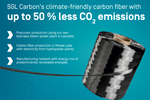SGL Carbon evaluates carbon fibers business strategy
After significant losses in 2023, SGL Carbon reviews all options for its Carbon Fibers Business Unit including a partial or complete divestment.

SGL Carbon SE (Wiesbaden, Germany) has announced that it is currently evaluating various strategic options for its carbon fibers (CF) business, including a possible partial or complete divestment of the business unit.
SGL Carbon’s carbon fibers business unit manufactures textile, acrylic and carbon fibers as well as composite materials at seven locations in Europe and North America. The company has reported that following a temporary drop in demand for carbon fibers from the wind industry market, the business unit’s sales and earnings fell significantly in the course of fiscal year 2023. In response, the company is reviewing all possibilities to support a positive further development of its carbon fibers business unit.
“After the restructuring from 2020 to 2022 and the stabilization year 2023, SGL Carbon is preparing for the next step of profitable growth,” says Dr. Torsten Derr, CEO of SGL Carbon SE. “We have positioned SGL Carbon in such a way that the four operating business units can be successful independently in their markets. In order to best exploit the development potential of our carbon fibers [business unit], we are currently evaluating all options, including a complete divestment. We are looking for a partner or new owner who can provide the necessary resources to further develop the Carbon Fibers business and position it successfully for the future.”
“As the Board of Management, it is our responsibility to make the best possible use of the company’s resources in the interests of all stakeholders to create the conditions for future profitable growth and an increase in the company’s value,” adds Thomas Dippold, CFO of SGL Carbon SE.
Related Content
-
Carbon fiber, bionic design achieve peak performance in race-ready production vehicle
Porsche worked with Action Composites to design and manufacture an innovative carbon fiber safety cage option to lightweight one of its series race vehicles, built in a one-shot compression molding process.
-
Plant tour: Albany Engineered Composites, Rochester, N.H., U.S.
Efficient, high-quality, well-controlled composites manufacturing at volume is the mantra for this 3D weaving specialist.
-
Welding is not bonding
Discussion of the issues in our understanding of thermoplastic composite welded structures and certification of the latest materials and welding technologies for future airframes.












